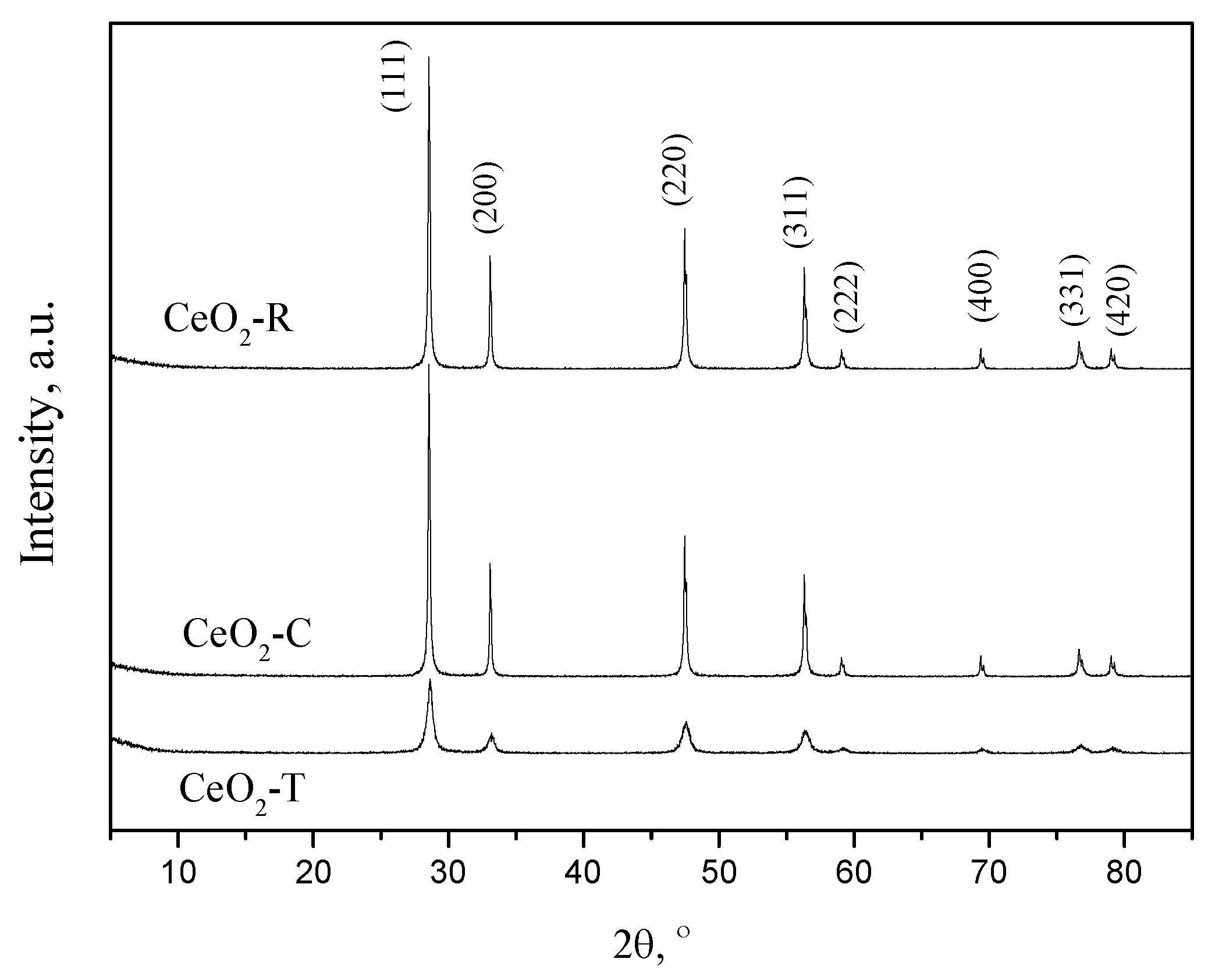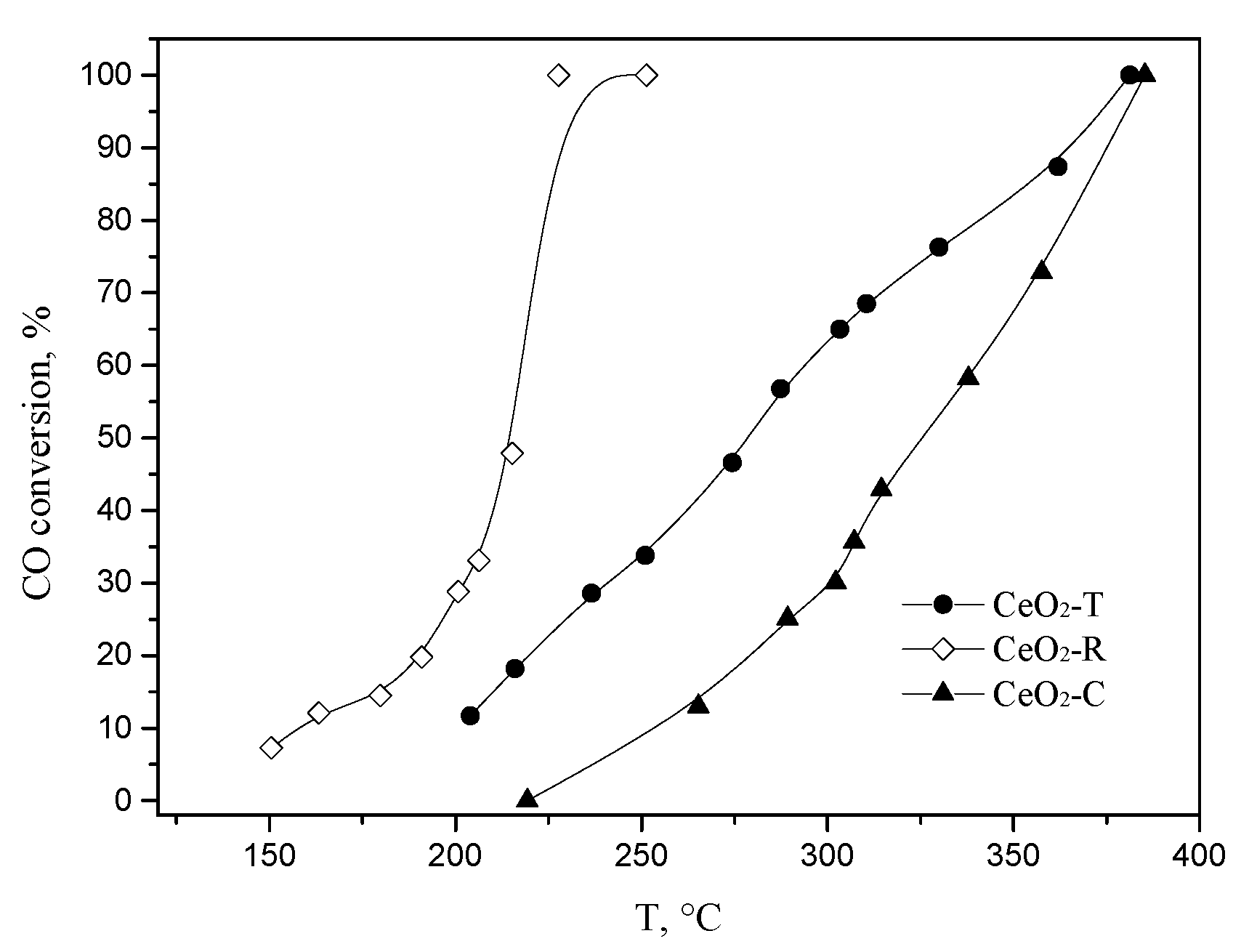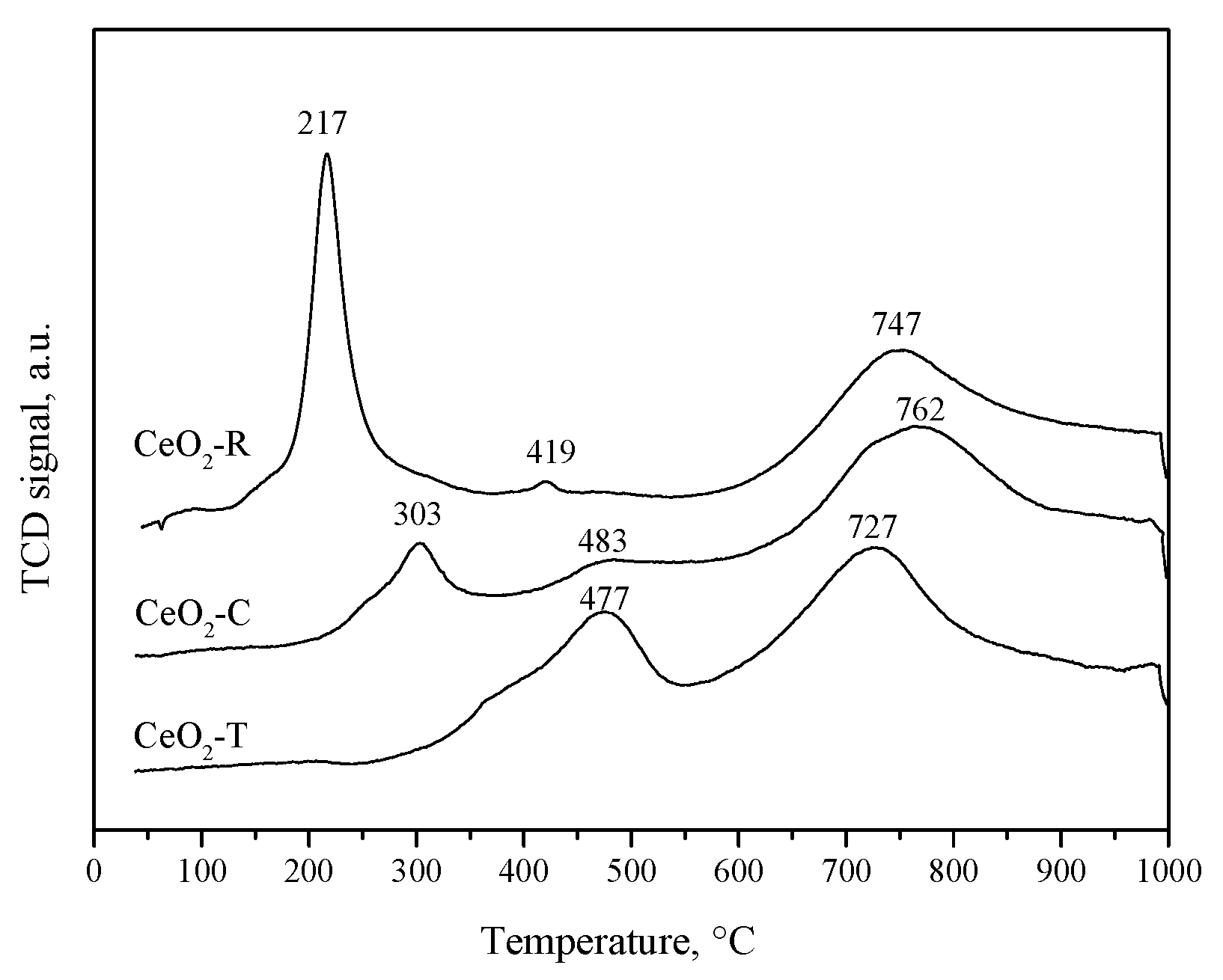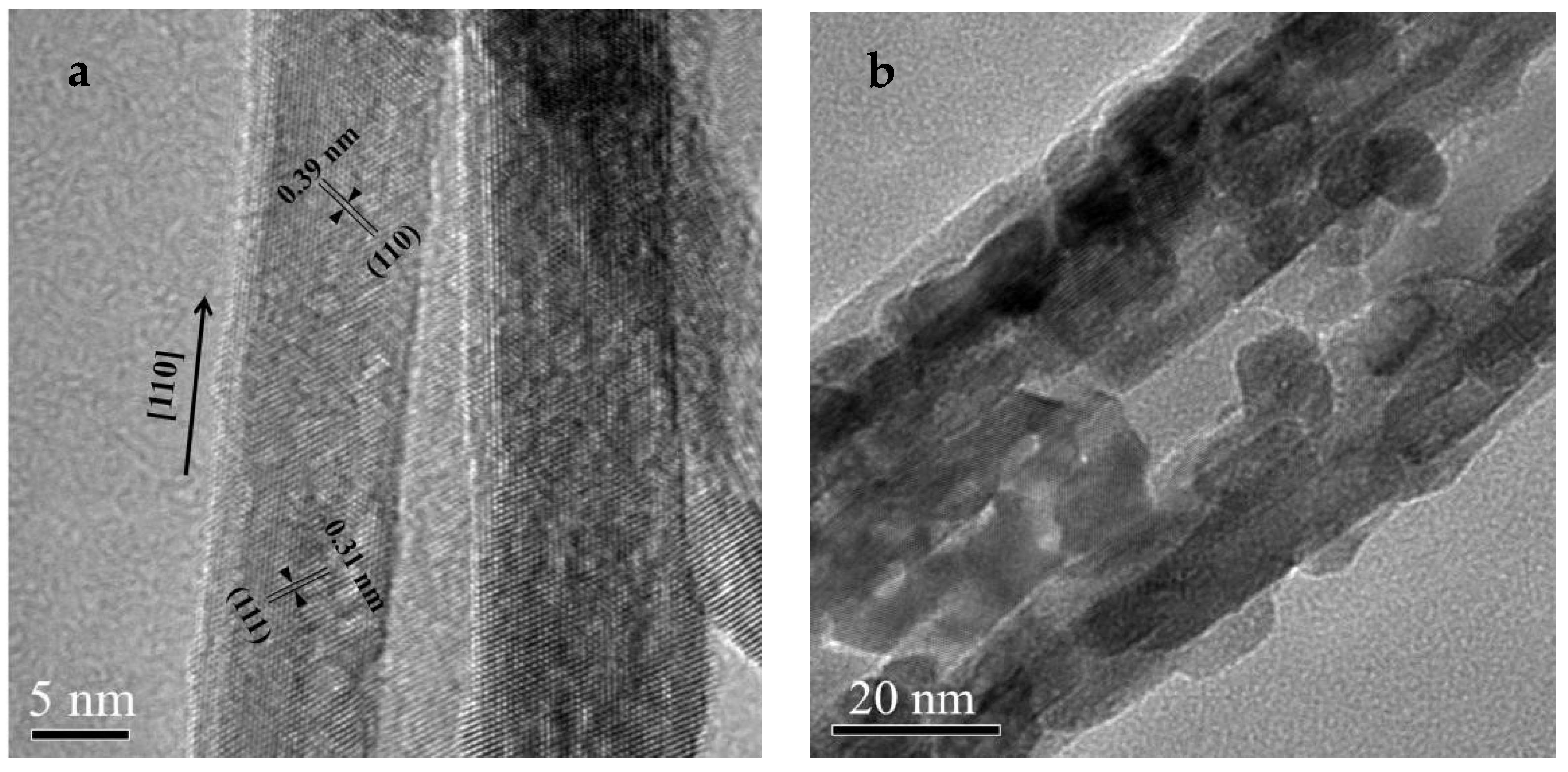Highly Reducible Nanostructured CeO2 for CO Oxidation
Abstract
1. Introduction
2. Results and Discussion
2.1. Catalyst Characterization
2.2. CO Oxidation Catalyzed by CeO2
3. Materials and Methods
3.1. Materials
3.2. Preparation of CeO2 with Different Morphologies
3.2.1. CeO2 Nanorods
3.2.2. CeO2 Nanotubes
3.2.3. CeO2 Nanocubes
3.3. Catalyst Characterization
3.4. Catalytic Activity Tests
4. Conclusions
Author Contributions
Funding
Conflicts of Interest
References
- Wang, J.X.; Zhuo, Y.; Zhou, Y.; Wang, H.J.; Yuan, R. Ceria doped zinc oxide nanoflowers enhanced luminol-based electrochemiluminescence immunosensor for amyloid-β detection. ACS Appl. Mater. Interfaces 2016, 8, 12968–12975. [Google Scholar] [CrossRef] [PubMed]
- Suzuki, K.; Miyazaki, H.; Yuzuriha, Y.; Maru, Y.; Izu, N. Characterization of a novel gas sensor using sintered ceria nanoparticles for hydrogen detection in vacuum conditions. Sens. Actuators B. Chem. 2017, 250, 617–622. [Google Scholar] [CrossRef]
- Chandrakala, E.; Praveen, J.P.; Kumar, A.; James, A.R.; Das, D. Strain-induced structural phase transition and its effect on piezoelectric properties of (BZT-BCT)-(CeO2) ceramics. J. Am. Ceram. Soc. 2016, 99, 3659–3669. [Google Scholar] [CrossRef]
- Kim, C.K.; Kim, T.; Choi, I.Y.; Soh, M.; Kim, D.; Kim, Y.J.; Jang, H.; Yang, H.S.; Kim, J.Y.; Park, H.K.; et al. Ceria nanoparticles that can protect against ischemic stroke. Angew. Chem. Int. Ed. 2012, 51, 11039–11043. [Google Scholar] [CrossRef] [PubMed]
- Xu, C.; Lin, Y.; Wang, J.; Wu, L.; Wei, W.; Ren, J.; Qu, X. Nanoceria-triggered synergetic drug release based on CeO2-capped mesoporous silica host-guest interactions and switchable enzymatic activity and cellular effects of CeO2. Adv. Healthc. Mater. 2013, 2, 1591–1599. [Google Scholar] [CrossRef] [PubMed]
- Montini, T.; Melchionna, M.; Monai, M.; Fornasiero, P. Fundamentals and catalytic applications of CeO2-based materials. Chem. Rev. 2016, 116, 5987–6041. [Google Scholar] [CrossRef] [PubMed]
- Mei, Z.; Li, Y.; Fan, M.; Zhao, L.; Zhao, J. Effect of the interactions between Pt species and ceria on Pt/ceria catalysts for water gas shift: The XPS studies. Chem. Eng. J. 2015, 259, 293–302. [Google Scholar] [CrossRef]
- Manwar, N.R.; Chilkalwar, A.A.; Nanda, K.K.; Chaudhary, Y.S.; Subrt, J.; Rayalu, S.S.; Labhsetwar, N.K. Ceria supported Pt/PtO-nanostructures: Efficient photocatalyst for sacrificial donor assisted hydrogen generation under visible-NIR light irradiation. ACS Sustain. Chem. Eng. 2016, 4, 2323–2332. [Google Scholar] [CrossRef]
- Haneda, M.; Kaneko, T.; Kamiuchi, N.; Ozawa, M. Improved three-way catalytic activity of bimetallic Ir–Rh catalysts supported on CeO2–ZrO2. Catal. Sci. Technol. 2015, 5, 1792–1800. [Google Scholar] [CrossRef]
- Alikin, E.A.; Vedyagin, A.A. High temperature interaction of rhodium with oxygen storage component in three-way catalysts. Top. Catal. 2016, 59, 1033–1038. [Google Scholar] [CrossRef]
- Lykhach, Y.; Figueroba, A.; Camellone, M.F.; Neitzel, A.; Skála, T.; Negreiros, F.R.; Vorokhta, M.; Tsud, N.; Prince, K.C.; Fabris, S.; et al. Reactivity of atomically dispersed Pt2+ species towards H2: Model Pt-CeO2 fuel cell catalyst. Phys. Chem. Chem. Phys. 2016, 18, 7672–7679. [Google Scholar] [CrossRef] [PubMed]
- Ang, M.L.; Oemar, U.; Saw, E.T.; Mo, L.; Kathiraser, Y.; Chia, B.H.; Kawi, S. Highly active Ni/xNa/CeO2 catalyst for the water–gas shift reaction: Effect of sodium on methane suppression. ACS Catal. 2014, 4, 3237–3248. [Google Scholar] [CrossRef]
- Mamontov, G.V.; Grabchenko, M.V.; Sobolev, V.I.; Zaikovskii, V.I.; Vodyankina, O.V. Ethanol dehydrogenation over Ag-CeO2/SiO2 catalyst: Role of Ag-CeO2 interface. Appl. Catal. A–Gen. 2016, 528, 161–167. [Google Scholar] [CrossRef]
- Wang, C.; Wen, C.; Lauterbach, J.; Sasmaz, E. Superior oxygen transfer ability of Pd/MnOx-CeO2 for enhanced low temperature CO oxidation activity. Appl. Catal. B. Environ. 2017, 206, 1–8. [Google Scholar] [CrossRef]
- Hou, T.; Yu, B.; Zhang, S.; Xu, T.; Wang, D.; Cai, W. Hydrogen production from ethanol steam reforming over Rh/CeO2 catalyst. Catal. Commun. 2015, 58, 137–140. [Google Scholar] [CrossRef]
- Wang, Y.; Zhao, J.; Wang, T.; Li, Y.; Li, X.; Yin, J.; Wang, C. CO2 photoreduction with H2O vapor on highly dispersed CeO2/TiO2 catalysts: Surface species and their reactivity. J. Catal. 2016, 337, 293–302. [Google Scholar] [CrossRef]
- Li, Y.; Shen, W. Morphology-dependent nanocatalysis on metal oxides. Sci. China Chem. 2012, 55, 2485–2496. [Google Scholar] [CrossRef]
- Yuan, Y.; Wang, Z.; An, H.; Xue, W.; Wang, Y. Oxidative carbonylation of phenol with a Pd-O/CeO2-nanotube catalyst. Chin. J. Catal. 2015, 36, 1142–1154. [Google Scholar] [CrossRef]
- Gawade, P.; Mirkelamoglu, B.; Ozkan, U.S. The role of support morphology and impregnation medium on the water gas shift activity of ceria-supported copper catalysts. J. Phys. Chem. C 2010, 114, 18173–18181. [Google Scholar] [CrossRef]
- Hou, F.; Li, H.; Yang, Y.; Dong, H.; Cui, L.; Zhang, X. Preparation and catalytic oxidation of CO with specific morphology and porous nano CeO2. Chem. Ind. Eng. Prog. 2017, 36, 2481–2487. [Google Scholar] [CrossRef]
- Zhou, Y.; Wang, Z.; Liu, C. Perspective on CO oxidation over Pd-based catalysts. Catal. Sci. Technol. 2015, 5, 69–81. [Google Scholar] [CrossRef]
- Ta, N.; Zhang, M.; Li, J.; Li, H.; Li, Y.; Shen, W. Morphology-dependent redox and catalytic properties of CeO2 nanostructures: Nanowires, nanorods and nanoparticles. Catal. Today 2009, 148, 179–183. [Google Scholar] [CrossRef]
- González-Rovira, L.; Sánchez-Amaya, J.M.; López-Haro, M.; del Rio, E.; Hungría, A.B.; Midgley, P.; Calvino, J.J.; Bernal, S.; Botana, F.J. Single-step process to prepare CeO2 nanotubes with improved catalytic activity. Nano Lett. 2009, 9, 1395–1400. [Google Scholar] [CrossRef] [PubMed]
- Zhang, X.; Hou, F.; Yang, Y.; Wang, Y.; Liu, N.; Chen, D.; Yang, Y. A facile synthesis for cauliflower like CeO2 catalysts from Ce-BTC precursor and their catalytic performance for CO oxidation. Appl. Surf. Sci. 2017, 423, 771–779. [Google Scholar] [CrossRef]
- Zhao, X.B.; You, J.; Lu, X.W.; Chen, Z.G. Hydrothermal synthesis, characterization and property of CeO2 nanotube. J. Inorg. Mater. 2011, 26, 159–164. [Google Scholar] [CrossRef]
- Pan, C.; Zhang, D.; Shi, L.; Fang, J. Template-free synthesis, controlled conversion, and CO oxidation properties of CeO2 nanorods, nanotubes, nanowires, and nanocubes. Eur. J. Inorg. Chem. 2008, 15, 2429–2436. [Google Scholar] [CrossRef]
- Zhan, W.C.; Guo, Y.; Gong, X.Q.; Guo, Y.L.; Wang, Y.Q. Surface oxygen activation on CeO2 and its catalytic performances for oxidation reactions. Sci. Sin. Chim. 2012, 42, 433–445. [Google Scholar] [CrossRef]
- Gurbani, A.; Ayastuy, J.L.; González-Marcos, M.P.; Gutiérrez-Ortiz, M.A. CuO-CeO2 catalysts synthesized by various methods: Comparative study of redox properties. Int. J. Hydrogen Energy 2010, 35, 11582–11590. [Google Scholar] [CrossRef]
- Li, X.; Chen, F.; Lu, X.; Ni, C.; Chen, Z. Modified-EISA synthesis of mesoporous high surface area CeO2 and catalytic property for CO oxidation. J. Rare Earth 2009, 27, 943–947. [Google Scholar] [CrossRef]
- Guo, M.N.; Guo, C.X.; Jin, L.Y.; Wang, Y.J.; Lu, J.Q.; Luo, M.F. Nano-sized CeO2 with extra-high surface area and its activity for CO oxidation. Mater. Lett. 2010, 64, 1638–1640. [Google Scholar] [CrossRef]
- Zhou, K.; Wang, X.; Sun, X.; Peng, Q.; Li, Y. Enhanced catalytic activity of ceria nanorods from well-defined reactive crystal planes. J. Catal. 2005, 229, 206–212. [Google Scholar] [CrossRef]
- Zhang, L.; Zhang, L.; Xu, G.; Zhang, C.; Li, X.; Sun, Z.; Jia, D. Low-temperature CO oxidation over CeO2 and CeO2@Co3O4 core-shell microspheres. New J. Chem. 2017, 41, 13418–13424. [Google Scholar] [CrossRef]






| Entry | Catalyst | SBET (m2/g) | Pore Volume (cm3/g) | Pore Diameter (nm) | Reaction Temperature (°C) 1 | ||
|---|---|---|---|---|---|---|---|
| T10 | T50 | T90 | |||||
| 1 | CeO2-R | 51.4 | 0.218 | 14.2 | 158 | 216 | 228 |
| 2 | CeO2-T | 55.6 | 0.158 | 11.5 | 203 | 278 | 366 |
| 3 | CeO2-C | 9.3 | 0.043 | 29.8 | 253 | 325 | 375 |
| Sample | Peak Temperature (°C) | H2 Uptake (μmol/g) | ||||
|---|---|---|---|---|---|---|
| Surface O-II | Surface O | Bulk O | Surface O-II | Surface O | Bulk O | |
| CeO2-T | --- | 477 | 727 | --- | 415 | 697 |
| CeO2-C | 303 | 483 | 762 | 193 | 208 | 668 |
| CeO2-R | 217 | 419 | 747 | 436 | 26 | 665 |
| Catalyst | SBET (m2/g) | TSOR1 (°C) | Feed Gas (mL·gcat−1·h−1) | T90 (°C) | References |
|---|---|---|---|---|---|
| CeO2-R | 51.4 | 217 | CO:O2:N2 = 1%/9%/90% (12,000) | 228 | This work |
| CeO2-R | 51.4 | 217 | CO:O2:N2 = 1%/9%/90% (18,000) | 242 | This work |
| CeO2-R | 51.4 | 217 | CO:O2:N2 = 1%/9%/90% (24,000) | 253 | This work |
| cauliflower like CeO2 | 74.5 | 490 | CO:O2:He = 1%/20%/79% (60,000) | 370 2 | [24] |
| CeO2 nanowires | 130 | ~527 3 | CO:O2:He = 1%/21%/78% (9000) | 300 | [22] |
| CeO2 nanorods | 128 | ~520 3 | CO:O2:He = 1%/21%/78% (9000) | 310 | [22] |
| CeO2 nanoparticles | 364 | --- | CO:O2:N2 = 1%/1%/98% (4800) | 282 | [30] |
| CeO2 core-shell microspheres | 87.8 | 487 | CO:O2:N2 = 1%/20%/79% (60,000) | 275 | [32] |
© 2018 by the authors. Licensee MDPI, Basel, Switzerland. This article is an open access article distributed under the terms and conditions of the Creative Commons Attribution (CC BY) license (http://creativecommons.org/licenses/by/4.0/).
Share and Cite
Feng, G.; Han, W.; Wang, Z.; Li, F.; Xue, W. Highly Reducible Nanostructured CeO2 for CO Oxidation. Catalysts 2018, 8, 535. https://doi.org/10.3390/catal8110535
Feng G, Han W, Wang Z, Li F, Xue W. Highly Reducible Nanostructured CeO2 for CO Oxidation. Catalysts. 2018; 8(11):535. https://doi.org/10.3390/catal8110535
Chicago/Turabian StyleFeng, Gang, Weining Han, Zhimiao Wang, Fang Li, and Wei Xue. 2018. "Highly Reducible Nanostructured CeO2 for CO Oxidation" Catalysts 8, no. 11: 535. https://doi.org/10.3390/catal8110535
APA StyleFeng, G., Han, W., Wang, Z., Li, F., & Xue, W. (2018). Highly Reducible Nanostructured CeO2 for CO Oxidation. Catalysts, 8(11), 535. https://doi.org/10.3390/catal8110535





